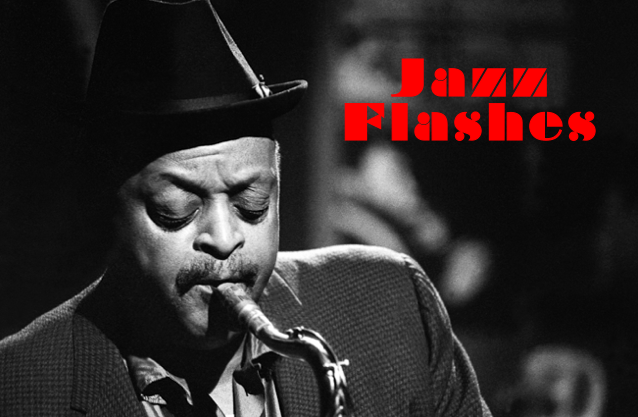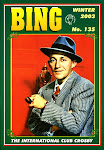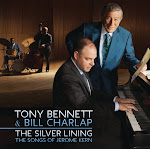Not only was
Bing Crosby one of the most important vocalists of the twentieth century—he was also one of the most prolific, entering the studio repeatedly pretty much every year between his first known recording session in 1926 and his last in 1977. And yet, despite the sheer amount of his output, very few of Crosby's albums and single releases remain unavailable on CD, the proliferation of all kinds of reissues causing inevitable, and often irritating, duplication of titles. This makes a CD-specific discography necessary for the dedicated and casual Crosby fan alike, a fact that
Frontis B. "Wig" Wiggins, of Arlington, Virginia, and his friend
Jim Reilly, of Portsmouth, England, realized many years ago, when they published their book
Bing Crosby's Commercial Recordings from 78s to CDs in 2001. Now, over a decade later, they have joined forces again to revise, update, and beautify that pioneering discography. The result,
The Definitive Bing Crosby Discography from 78s to CDs, is a very attractive book that contains a wealth of information about Der Bingle's recording sessions with an eye to simplifying anyone's hunting for CD reissues of Crosby material from any period of his long, successful career.
The book is very well put together, carefully researched, and generously illustrated mostly with color pictures, and its intelligent organization, with all sorts of interesting indexes, makes it a joy to browse through. This is definitely not the kind of discography that only lists titles, dates, locations, backing orchestras, and catalog numbers; it also includes brief essays that discuss various aspects of Crosby's career, thus making the book appealing also to casual fans that may be interested in learning a little about each phase of Crosby's recorded legacy in addition to perusing a complete listing of masters, alternate takes, unreleased and non-commercial recordings, and even titles that contain studio errors, like his famous fluff on a rejected take of
"Wrap Your Troubles in Dreams." The Vintage Bandstand has recently had the chance to interview Mr. Wiggins, who currently serves as the American and Canadian representative of the International Club Crosby, on the subject of the book, which is indispensable for both Crosby and popular music aficionados. As he mentions in the interview, a supplement to this discography, detailing all of Crosby's radio recordings that have been officially authorized for release on CD by Bing Crosby Enterprises, is in the works, and we are eagerly awaiting it. Before proceeding to the interview, we would like to express our most sincere gratitude to the authors for their wholehearted dedication to this project, which makes the lives of Crosby fans and collectors a great deal easier.
 |
| Bing Crosby with Frank Sinatra, and Judy Garland in the 1940s |
Anton Garcia-Fernandez (for The Vintage Bandstand): When and how did the idea occur to you to begin such a daunting project as this Bing Crosby discography?
Mr. Wiggins: When the CD era began, I started annotating my personal discography each time a song title was reissued on CD to help organize my own collection. After a while my friend Jim Reilly, of England, and I decided it would be useful to publish a first version of a CD-oriented discography for others, which was entitled
Bing Crosby's Commercial Recordings—From 78s to CDs. It was issued in 2001 and was very popular but has long been out of print. About four years ago we concluded that so many additional CD reissues had appeared that a revised and updated edition was desirable. We then spent at least three years exchanging telephone calls and e-mails to prepare this new edition for publication.
TVB: What was the rationale that you and Mr. Reilly followed as you began the project?
Mr. Wiggins: As there was no other current printed discography available that indicated which of Bing's recordings had been reissued on CD, and this was the manner by which most collectors were acquiring them, we thought a new edition of our original book would be appealing and useful to Crosby fans.
TVB: What is new and different about your discography when compared to other Crosby discographies available online and in book form?
Mr. Wiggins: The main differences are the following: (1) A listing of the original commercial release of each title on 78s, 45s, LPs, or CDs; (2) a listing of a recommended CD version of each title that has been released on CD; (3) a listing of the names of composers, orchestra leaders, and vocal accompanists; (4) the addition of sixty unnumbered illustration and information pages, most of them in color; (5) an exclusive new section entitled "Unreleased Studio Recordings"; and (6) multiple indexes to facilitate identification of entries and to make use easier.
TVB: This is an invaluable reference work for serious Crosby fans, but what is the appeal of the book for the more casual fan?
Mr. Wiggins: The addition of the sixty extra pages giving information about various aspects of Bing's overall career, including his films and radio broadcasts, for example, as well as lists of his "Gold Records," "Top Hits," and "Bing's Hollywood Songs," among other general information.
TVB: What aspects of this project were the most difficult to tackle for you and Mr. Reilly?
Mr. Wiggins: The creation and verification of the original commercial release of each song, wherever in the world. This new and unique feature was completed in consultation with other leading Crosby collectors over a number of years.
TVB: As you mentioned, the book is profusely illustrated with color pictures and contains some very interesting indexes and even lists of unreleased Crosby recordings and alternate takes. How many years did you and Mr. Reilly spend working on this project?
Mr. Wiggins: Jim Reilly and I have worked together since the early 1990s on recordings by Bing. For at least a decade I was consultant to MCA / Universal Music in Los Angeles, compiling and annotating Bing Crosby collections for reissue on CD, and Jim played the same role for the same company in London. This led to our three- to four-year project to publish our first discography in 2001, and then another three-year effort to update our new version.
TVB: What, if anything, have you left intentionally out of the book?
Mr. Wiggins: We decided it was best not to include Bing's extensive number of so-called "radio recordings," as this would have made the project too large and almost unending. As stated in the "Introduction" to this edition, we plan to produce a supplement to be entitled
Special Radio Recordings. This will include all radio recordings authorized for release on CD by Bing Crosby Enterprises, such as the Mosaic CD box set of Bing's many songs recorded with
Buddy Cole, along with other such compilations.
 |
| Louis Armstrong, Frank Sinatra, Peggy Lee, and Bing Crosby in the late 1950s |
TVB: It seems that the book is selling rather well. What kind of responses have you received so far from Crosby collectors and fans?
Mr. Wiggins: Thus far, only telephone calls and brief notes of thanks praising the overall quality and content of our book have been received. Some have also expressed appreciation for the "Recommended CD" column, for helping to guide their collecting while avoiding excessive duplication. We have been disappointed, however, at the complete lack of any internet comments to date.
TVB: And finally, if you had to recommend three Bing Crosby releases to someone who is interested in getting acquainted with Crosby's phenomenal body of work, which ones would you choose? Thanks again to you and Mr. Reilly for your wonderful work on this new Crosby discography!
Mr. Wiggins: For the newer Crosby fan, or for one who is just starting out, I would recommend the following CDs:
Bing's Gold Records (MCA / Universal MCAD-11719),
Merry Christmas, which was retitled
White Christmas (MCA / Universal MCAD-31143), and
A Centennial Collection of Bing Crosby's Decca Recordings (MCA / Universal MCAD-88-113222). A single alternative to these would be the four-CD box set,
Bing—His Legendary Years (MCA / Universal MCAD4-10887).
Further information
For more information about this new Bing Crosby discography (its price is US$35, postpaid via Priority Mail), as well as for ordering the book, you can contact Mr. Wiggins at the following mailing address: 5608 North 34th Street, Arlington, Virginia 22207, U.S.A. Mr. Wiggins will also take orders by phone (703-241-5608) and e-mail (wigbing2012 (at) gmail.com). The discography is also announced in the International Club Crosby website, where you can find information about how to order it if you live in the United Kingdom, Ireland, Australia, and New Zealand. If interested, please
go here.

















































